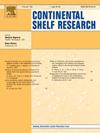Wind-driven variability in longshore transport of SPM in the turbidity maximum zone along the Dutch coast
IF 2.2
3区 地球科学
Q2 OCEANOGRAPHY
引用次数: 0
Abstract
Long-term measurements from a mooring off the Dutch coast, placed in the turbidity maximum zone (TMZ), are analyzed to study the temporal variability of the alongshore transport of SPM (Suspended Particulate Matter), covering a two-year period. In particular, the effect of wind speed and wind direction is investigated, as it is dominant over the tidal effect. The data reveal that the general net transport at the mooring location is northward; annually, the mean northward transport is 1 kton per meter in the cross-shore direction. For calm conditions, when wind speeds are less than 5 m/s, the overall effect of winds on the net transport diminishes to zero. Energetic conditions (wind speed higher than 5 m/s) are studied for a sequence of storms from opposing wind directions. Here, the gross tidal transports (i.e., transport during ebb or flood separately) show a delay with respect to the onset of the wind event, ranging from half a day to a day. The correlation between the net transport per tidal cycle and the wind characteristics during that cycle, is used to extrapolate the results to a 10-year period, using wind data from a nearby weather station. It is shown that annual transports of SPM can vary by a factor of two between years, due to different wind and wave conditions. Within a year the seasonal variability is larger, a factor of five exists between summer and winter months.
荷兰海岸浊度最大带SPM海岸运输的风驱动变率
从荷兰海岸停泊处放置在浊度最大带(TMZ)的长期测量数据进行了分析,以研究SPM(悬浮颗粒物)沿海岸运输的时间变化,为期两年。特别是,风速和风向的影响进行了研究,因为它是主导的潮汐效应。数据显示,系泊位置的总体净输运向北;年平均向北输送量为每米1千吨。在平静条件下,当风速小于5米/秒时,风对净输送的总体影响减小到零。研究了来自相反风向的一系列风暴的高能条件(风速高于5米/秒)。在这里,总潮汐输运(即分别在退潮或涨潮期间输运)相对于风事件的开始表现出延迟,从半天到一天不等。利用附近气象站的风数据,利用每个潮汐周期的净输送量与该周期内的风特征之间的相关性,将结果外推到10年期间。结果表明,由于风浪条件的不同,SPM的年输送量可以变化2倍。在一年内,季节变化较大,夏季和冬季之间存在5个因子。
本文章由计算机程序翻译,如有差异,请以英文原文为准。
求助全文
约1分钟内获得全文
求助全文
来源期刊

Continental Shelf Research
地学-海洋学
CiteScore
4.30
自引率
4.30%
发文量
136
审稿时长
6.1 months
期刊介绍:
Continental Shelf Research publishes articles dealing with the biological, chemical, geological and physical oceanography of the shallow marine environment, from coastal and estuarine waters out to the shelf break. The continental shelf is a critical environment within the land-ocean continuum, and many processes, functions and problems in the continental shelf are driven by terrestrial inputs transported through the rivers and estuaries to the coastal and continental shelf areas. Manuscripts that deal with these topics must make a clear link to the continental shelf. Examples of research areas include:
Physical sedimentology and geomorphology
Geochemistry of the coastal ocean (inorganic and organic)
Marine environment and anthropogenic effects
Interaction of physical dynamics with natural and manmade shoreline features
Benthic, phytoplankton and zooplankton ecology
Coastal water and sediment quality, and ecosystem health
Benthic-pelagic coupling (physical and biogeochemical)
Interactions between physical dynamics (waves, currents, mixing, etc.) and biogeochemical cycles
Estuarine, coastal and shelf sea modelling and process studies.
 求助内容:
求助内容: 应助结果提醒方式:
应助结果提醒方式:


